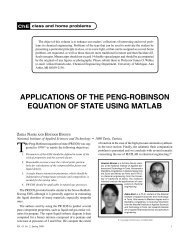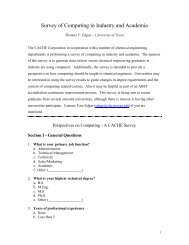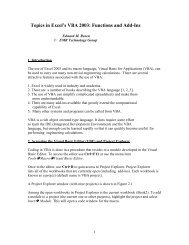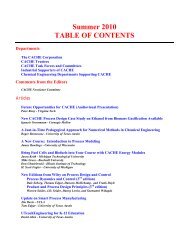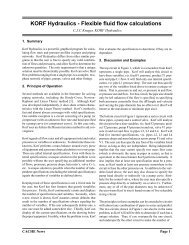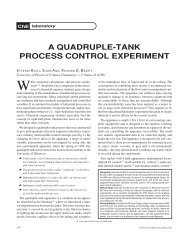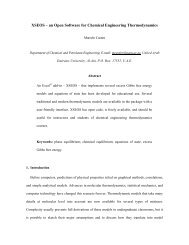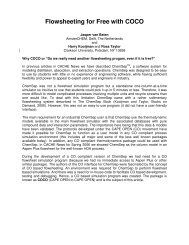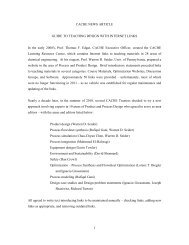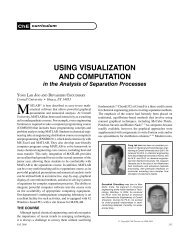Product and Process Design Courses Product and Process Design ...
Product and Process Design Courses Product and Process Design ...
Product and Process Design Courses Product and Process Design ...
You also want an ePaper? Increase the reach of your titles
YUMPU automatically turns print PDFs into web optimized ePapers that Google loves.
<strong>Product</strong> <strong>and</strong> <strong>Process</strong> <strong>Design</strong> <strong>Courses</strong><br />
Department of Chemical & Biochemical<br />
Engineering<br />
Technical University of Denmark<br />
Rafiqul Gani<br />
EURECHA Session, ESCAPE‐20, Ischia, 6‐9 June 2010<br />
1
P<strong>Process</strong> ddesign: i Pi Principles i l &<br />
methods<br />
MSc‐level l lcourse<br />
10 ECTS points course<br />
114 weeks k course; 8 hhours per week k plus l additional ddi i l<br />
time in working on the process design project<br />
More information (lecture slides, exercise problems, etc., can be obtained<br />
from Rafiqul Gani (rag@kt.dtu.dk)<br />
EURECHA Session, ESCAPE‐20, Ischia, 6‐9 June 2010<br />
2
Course 28350 (Spring ( p g 2010) )<br />
<strong>Process</strong> <strong>Design</strong>: Principles <strong>and</strong> Methods<br />
(Chemical <strong>and</strong> Bio-chemical)<br />
Textbook: Systematic Methods of Chemical <strong>Process</strong> <strong>Design</strong> (Biegler, Grossmann<br />
& Westerberg) plus Notes<br />
Lecture Plan: 12 lecture periods (4 hours per week) plus tutorials <strong>and</strong> exercises<br />
(4 hours per week) covering a 14‐week period (February‐May)<br />
Exam: <strong>Design</strong> project report, oral presentation of the design project, <strong>and</strong> 3 exam<br />
problems<br />
<strong>Design</strong> Project: <strong>Design</strong> project is given at the start of the course <strong>and</strong> must be<br />
delivered on or before the specified deadline (last day of the course)<br />
Grading: Based on submitted design project report, exam problems, <strong>and</strong> oral<br />
presentation of the design project (7‐scale system)<br />
EURECHA Session, ESCAPE‐20, Ischia, 6‐9 June 2010 3
Raw Material<br />
Definition of Chemical <strong>Process</strong> <strong>Design</strong><br />
Chemical<br />
<strong>Process</strong><br />
??<br />
Chemical <strong>Product</strong><br />
Ch Chemical i l process ddesign i iis about b tfi finding di a sustainable t i bl<br />
process that can convert the raw materials to the desired<br />
chemical products<br />
Sustainable: Economic, low environmental impact, low<br />
waste waste, efficient operation, operation correct raw material material, …..<br />
EURECHA Session, ESCAPE‐20, Ischia, 6‐9 June 2010 4
Chemical <strong>Process</strong> <strong>Design</strong>: Important Issues<br />
• <strong>Process</strong> design is about making design decisions (which<br />
decisions, when & how?), verifying if they are acceptable, <strong>and</strong><br />
if not, iimprove the h design d i with ihb better decisions d i i<br />
• The process design problem starts with the identification of a<br />
chemical product that needs to be made from a selected raw<br />
material<br />
• <strong>Process</strong> simulators should not be used for blind trial <strong>and</strong> error<br />
but for fast evaluation of design decisions<br />
• <strong>Process</strong> design is iterative by nature but if a systematic<br />
procedure is followed, better results can be obtained faster<br />
• Use everything (knowledge) that has been learnt from other<br />
courses<br />
Methods & tools used: Conceptual design methods; ICAS, PROII; ......<br />
EURECHA Session, ESCAPE‐20, Ischia, 6‐9 June 2010 5
Chemical <strong>Process</strong> <strong>Design</strong>: Organization<br />
of the work<br />
<strong>Process</strong> design g work is divided into 12 hierarchical<br />
tasks<strong>and</strong> the students are encouraged to follow the<br />
tasks.<br />
The lectures are organized to highlight the tasks<br />
<strong>and</strong> how to perform them them.<br />
The students are encouragced g to make partial p<br />
reports for each task <strong>and</strong> later combine them to<br />
form the full design project report.<br />
Students work in groups of 2-3 <strong>and</strong> are encouraged<br />
to follow a strict time-table.<br />
time-table<br />
EURECHA Session, ESCAPE‐20, Ischia, 6‐9 June 2010 6
<strong>Process</strong> <strong>Design</strong> Tasks 1‐6<br />
• Task 1: Collect information about the product <strong>and</strong> the raw<br />
materials that could be used to make it<br />
• Task 2: Collect information on the path to convert the raw<br />
material to the desired product (that is, an idea of the process)<br />
• Task 3: Generate (<strong>and</strong>/or select) preliminary process flowsheet<br />
• Task 4: Decide process conditions (such as reaction conversion conversion,<br />
separation factor, purge, etc.) <strong>and</strong> perform a preliminary mass<br />
balance on the selected flowsheet<br />
• Task 5: Based on the results from above, set temperatures <strong>and</strong><br />
pressures on the process flowsheet<br />
• Task 6: Based on the results from above, perform a preliminary<br />
mass & energy balance<br />
EURECHA Session, ESCAPE‐20, Ischia, 6‐9 June 2010 7
<strong>Process</strong> <strong>Design</strong> Tasks 7‐12<br />
• Task 7: Perform detailed process simulation –convert each of<br />
the simple models with the more rigorous option, one at a<br />
ti time, until til all ll simple i l models dlhhave bbeen converted. td<br />
• Task 8: Based on the simulation results from task 7, perform<br />
equipment q p sizing g <strong>and</strong> costing g calculations<br />
• Task 9: Based on the results from tasks 1‐8, perform an<br />
economic evaluation, using the current design as the “base<br />
case” ”<br />
• Task 10: Investigate if opportunities for heat <strong>and</strong> mass<br />
transfer exist. If yes, apply apply them <strong>and</strong> check by how much the<br />
cost of operation can be further reduced?<br />
• Task 11: Perform environmental impact analysis<br />
• Task k 12: 2 Investigate i hhow the h current design d i can bbe ffurther h<br />
improved by formulating & solving an appropriate process<br />
optimization problem<br />
EURECHA Session, ESCAPE‐20, Ischia, 6‐9 June 2010 8
Computer Aided Chemical<br />
P<strong>Product</strong> d tD <strong>Design</strong> i<br />
MSc‐level course<br />
75ECTS 7.5 ECTS points course<br />
14 weeks course; course; 4 hours per week; case study<br />
approach using computer aided methods & tools<br />
More information (lecture slides, exercise problems, etc., can be obtained<br />
from Rafiqul Gani (rag@kt.dtu.dk)<br />
EURECHA Session, ESCAPE‐20, Ischia, 6‐9<br />
June 2010<br />
9
Special PhD‐Course (also taken as a special course at MSc‐<br />
level): Computer Computer‐Aided Aided Chemical <strong>Product</strong> <strong>Design</strong><br />
• 2 weeks intensive course based on the case study<br />
approach h ( (plus l exam problem bl for f another h two weeks) k)<br />
• Course involves lectures <strong>and</strong> tutorials<br />
• Methods <strong>and</strong> tools needed to solve some features of<br />
chemicals based product design problems are highlighted<br />
through case studies<br />
• Exam problems cover similar products discussed in the<br />
case studies<br />
• 75ECTS 7.5 ECTS points i t<br />
• Grading: Based on submission of report of exam<br />
problems<br />
• Time: January‐February 2011<br />
• To be given by Prof Rafiqul Gani, DTU‐Chemical<br />
Engineering
Special PhD‐Course: Computer‐Aided Chemical <strong>Product</strong> <strong>Design</strong><br />
Part I<br />
•Molecular design (solvents, refrigerants, process fluids, ....) –CAMD<br />
•Binary mixtures ( (solvent l tmixtures, it non‐azeotropes; t azeotropes; t ....) ) –<br />
CAMD<br />
•Polymer Polymer design (repeat unit design) – CAMD<br />
•Active Ingredient (backbone) design –ProPred, CAMD, Database<br />
Part II<br />
•Mixture (blend) design – graphical method <strong>and</strong> mixture design<br />
tool<br />
•<strong>Product</strong> performance verification (controlled release, AI‐uptake, ...) –<br />
CAMD, , MoT, , Virtual <strong>Product</strong>‐<strong>Process</strong> <strong>Design</strong> g<br />
•Formulation design (virtual experiments) – vPPD‐lab<br />
•Integrated product‐process design –PropRed, CAMD, ICAS,<br />
Database
Two MSc-level MSc level courses were presented in<br />
this lecture (process design & computer<br />
aided product design)<br />
•<strong>Courses</strong> on process control control,<br />
introduction to product <strong>and</strong> process<br />
design <strong>and</strong> hazards-safety hazards safety are also given<br />
at the BSc- & MSc-levels<br />
•<strong>Courses</strong> on computer-aided modelling,<br />
modelling under uncertainty, uncertainty processtools<br />
integration, <strong>and</strong>, advances in PSE<br />
are also given at PhD PhD-level<br />
level<br />
EURECHA Session, ESCAPE‐20, Ischia, 6‐9 June 2010<br />
12




